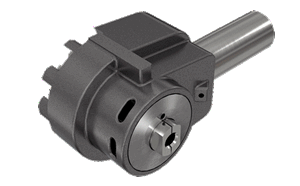The Right PC CNC Brings Speed to Moldmakers
What to look for in a control to get the speed, accuracy, surface finish, flexibility, convenience and value a moldmaker needs.
Recent advancements in industrial PC CNC controls have opened a new technology path to improved speed, accuracy, surface finish, flexibility and convenience for moldmaking, along with greater value. Here is a review of some of the features of the next generation controls you should consider when investigating your next PC CNC control purchase.
Capability Considerations
Memory
Next generation controls are specifically designed for mold and die machining and feature dual processors separately dedicated to the interface and motion control functions of the machine. Among many basic advantages to owners, program memory in these controls is user upgradeable. A control equipped with 2MB of standard program memory can be upgraded with commercially available compact flash memory, eliminating the cost and availability issues associated with proprietary memory modules.
Processing and Execution Speed
The latest dual-processor controls can deliver a much-improved 1,500 blocks per second processing speed simultaneously across three interpolated axes, compared with conventional BPS ratings across one axis only. While block processing speed is often cited as a measure of a control's capability, the true measure is block execution speed, which factors in servo update rates and interpolation rates. Newer control platforms have 4 millisecond servo update and interpolation rates. As a result, data for 2-D and 3-D contouring cuts is processed quickly to allow extremely high speeds and feeds, without lag, dwell or run-on. These powerful new features work seamlessly with 3,000-block look ahead and highly accurate control path algorithms to ensure both part and path are executed exactly as programmed, without blending.
Performance-Specified Machining
Performance-specified machining is a new capability that allows machine operators to choose appropriate levels of speed and accuracy required during any phase of a part program, using a sliding scale. For example, the operator might opt for increased speed during the initial roughing passes then adjust to increased accuracy for the surface finishing passes. Performance-specified machining actually retunes the servo gains, PID loops and other parameters that would take considerable time to do manually, if the operator were capable of doing it at all. And while older controls may require the machine to be idled or off while new servo parameters are dialed in, the next-generation controls give the operator direct access to the line of code to choose exact levels of performance desired, on the fly and without disruption. Setup of the basic servo parameters at machine startup is automatic and 100 percent accurate with software technology that identifies all hardware at startup and populates the CNC with the needed data, eliminating any potential for operator errors.
Software
Software packages designed for use with the new controls in mold/die applications include control-resident CAM systems for shop floor programming. This powerful, integrated CAM package is more intuitive, flexible and scalable than traditional conversational programming systems—empowering operators to rapidly create programs for part geometries that range from simple to complex.
PC Hardware Advantage
CNC users have long faced challenges with the most popular hardware platforms, largely because new hardware must retain some degree of interface and hardware compatibility with legacy systems, even as new capabilities and features are grafted on. The industrial PC platform has an inherent plug-and-play advantage in robustness and scalability. Built for life on the shop floor, the new controls have no moving parts, no fan or hard disc—the two most common failure modes in earlier controls. As you'd expect on a PC, the new controls have Ethernet ports and fully functional USB 2.0 ports to enable drip-feeding a part program from an external drive. PC control platforms are customizable, and can be user-upgraded from mild to wild as machining requirements change. An owner who purchases a general- purpose control for standard machining can upgrade to a twin-CPU mold/die package with plug-in components. Specially-designed portals on the new controls make it easy to seamlessly integrate state-of-the-art third-party tools, such as a digital scanner or part probes and verification software. Even the flash memory recommended for expansion works with the control's software, which writes data in different areas of the card all the time to enhance life and reliability. The use of commercially available memory cards is a real cost advantage for mold shops where part programs are often quite large.
Eye on Green
Like many new manufacturing products and processes today, the new PC controls are also designed with an eye on green issues. In addition to fan-less cooling, the controls' servo systems use regenerative braking to capture and store decel energy, and allow DC buss sharing between drives. If one axis is performing at it highest level and another is idling, the harder working axis can draw upon the unused power from the idling axes.
Summary
For moldmakers to stay competitive with the low-cost labor of today's global market, per part costs and leadtimes must be reduced and strict quality standards met. This results in a greater reliance on automation and faster, more flexible and accurate methods of production. The new generation of industrial PC CNC controls addresses these needs with increased processing speeds, improved compatibility with third-party tools, and low ownership cost.
Related Content
Precision Meets Innovation at IMTS 2024
After attending IMTS, it's clear that the integration of advanced technologies is ready to enhance precision, efficiency and automation in mold manufacturing processes. It’s a massive event, so here’s a glimpse of what the MMT team experienced firsthand.
Read MoreMold Innovations Power Unique Auto Lighting Elements on Hummer EVs
Diamond machining, electroforming of micro-optical inserts and modified latch-lock system help injection molds produce unique forward lighting elements.
Read More3D Printing Enables Better Coolant Delivery in Milling Operations
Just like 3D printing enabled conformal cooling channels in molds, additive manufacturing is now being used to optimize coolant delivery in cutting tools.
Read MoreRead Next
Consider The Control Before You Buy
Your machining center’s control could mean the difference between rapid productivity and costly downtime.
Read MoreAre You a Moldmaker Considering 3D Printing? Consider the 3D Printing Workshop at NPE2024
Presentations will cover 3D printing for mold tooling, material innovation, product development, bridge production and full-scale, high-volume additive manufacturing.
Read MoreHow to Use Strategic Planning Tools, Data to Manage the Human Side of Business
Q&A with Marion Wells, MMT EAB member and founder of Human Asset Management.
Read More





















